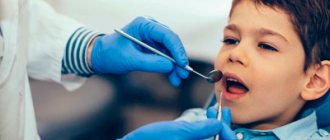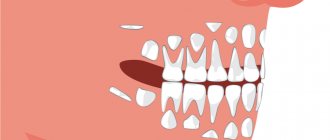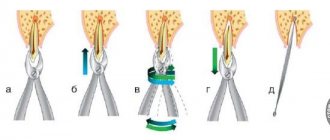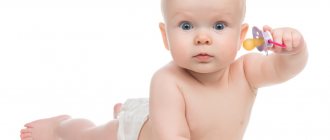- Treatment of caries and pulpitis of milk teeth
- Treatment of caries and pulpitis for children and adolescents under 16 years of age
- Children's prevention and hygiene
- Tooth extraction for children
- Anesthesia for children
If we talk about tooth extraction in children, then first of all we will talk about the removal of milk teeth for dental reasons and during the period of physiological change of teeth to permanent ones.
Permanent teeth have to be removed in children for the same reasons as in adults, and you can read about this in our article on tooth extraction.
How does baby teeth fall out?
The replacement of baby teeth with permanent ones is a physiological process. By the age of 3, a child grows 20 milk teeth in his mouth, which differ in structure from permanent teeth. They have thinner enamel and walls, and more branched roots. Then, gradually, the roots of baby teeth begin to dissolve. At the age of 5-6 years, baby teeth begin to loosen and fall out in the order in which they appeared, and in their place permanent teeth grow from the rudiments. The period of formation of a permanent dentition lasts up to 13-14 years and the appearance of 7 teeth - the second molars - ends. Healthy baby teeth and natural, timely replacement of teeth guarantee the child healthy teeth in his permanent dentition. Therefore, it is best if baby teeth fall out on their own and do not require additional doctor intervention, but this does not always happen.
Signs about whether it is possible and necessary to preserve a child’s baby teeth
Milk teeth are a thread that connects a person with his ancestors, so signs advise observing dental traditions
For all nations, incisors represent a connection with past generations. Violation of integrity is considered a harbinger of troubles and misfortunes. Specimens not disposed of by relatives can become excellent material for causing damage and the evil eye.
The statement that keeping baby teeth is a bad omen is quite controversial. Opinions vary greatly, so everyone makes their own choice.
The following reasons are put forward in favor of preserving molars:
- the body must be buried with a full set of teeth so that the soul does not have to look for them;
- The baby tooth has strong protection; it cannot be taken away from the child;
- neglectful treatment of incisors will negatively affect the fate of the child.
Magicians, esotericists and superstitious people believe that by getting rid of teeth, you can protect your child from witchcraft.
Each nation has its own traditions of getting rid of them.
Among nomadic peoples
Nomads buried a child’s first milk teeth in the ground to provide the baby with reliable protection from damage. And sedentary peoples made amulets and amulets, which they spoke, then placed in red cloth, tied with thread and always carried with them.
Among the Poles
In Polish families, children bury their lost teeth in the garden. At the same time, it is important that no one sees them, otherwise you will have to wait a long time for a replacement, and new molars will cause many problems.
English traditions
English customs dictate that fallen baby teeth be immediately destroyed by any available means. Most of all, the British fear that the biomaterial may be accidentally swallowed by a pet. According to national superstitions, in this case the child will grow fangs like an animal. The child's smile will be ugly.
Some Indian tribes are proud of their fangs, so they do not dispose of their teeth.
In order to protect against witchcraft, it is customary for the British to burn baby teeth. No sorcerer will be able to use the destroyed biomaterial. The child will be under reliable protection.
Superstitions of Slavic peoples
The Slavic group of peoples gives the fallen molars to the norushka. Turning their backs to the stove, they say the words: “Mouse-mouse, give me a bone tooth in exchange for a turnip tooth,” and throw it over their heads into the corner.
Traditions of Western countries
In the United States, Germany, France, Italy, traditions are more practical. The baby molar is given to the Tooth Fairy in order to exchange it for a coin.
Dental custom in Switzerland
It is not a fairy, but an ant who comes to the little Swiss to get their teeth. He also exchanges it for money.
Gypsy customs
The gypsies throw the chisel to the Moon. They believe that this ritual will bring good luck to the child, protect him from enemies and provide protection for life.
Asian dental beliefs
In Asian countries, a baby tooth is thrown onto the roof of the house where the child who lost it lives. It is believed that this way he receives protection from damage.
In Korea, India, China, and Vietnam, this ritual is performed only with lower row molars. A squirrel or bird will give you a new one in return - strong and healthy. The upper incisors, on the contrary, were hidden on the floor or thrown under the bed for a mouse to find.
In Turkey
The traditions of the Turks are the most practical. They believe that through children's teeth they can influence the future professional life of the child. Parents themselves dispose of the tooth and bury it in those places where, according to their preference, the child should make a career: school, hospital, prosecutor's office. Football fields are given special honor in Turkey.
Attention! All parents should remember that when changing children's teeth, it is imperative to visit a dentist. It will help relieve toothache and tell you how to properly
treat the wound to avoid infection.
Is it possible to remove a baby tooth at home?
The human body is programmed to independently change teeth without complications. If the child does not have dental or general diseases, then the natural loss of a baby tooth is the most desirable scenario. You don't need to do anything to do this. Just when a child’s tooth is loose, pay extra attention to hygiene, because brushing a child’s loose teeth on their own is painful. Make sure that the child does not touch the tooth with his hands - it can cause an infection.
How to help a baby tooth fall out on its own?
The simplest and most effective way is to give your child something hard to chew on, such as an apple. It is better to refuse threads and other fancy devices.
If you decide to help the process a little and remove the interfering tooth yourself, clamp it with a sterile napkin, try to turn it a little around its axis and remove it. Do not “twist” the tooth with force or put pressure on it, so as not to damage the bone and soft tissue. After removal, have your child bite on a sterile cotton swab for 10-15 minutes. There is no need to rinse your mouth after removal; do not feed your child solid food or hot foods for several days.
If you suspect that the tooth has not been completely removed, or the child complains that there is a sharp edge in the hole that “scratches” - contact your dentist as soon as possible.
Superstitions about the first tooth
First tooth
The appearance of the first tooth most often occurs between 4 and 6 months of a child’s life. If the first tooth grew earlier, signs and customs promised the mother the next pregnancy. It had to come very quickly if the tooth grew first from above. There were other beliefs about the time of the appearance of the first teeth.
Free Online Tarot Course Eliminate 10 Key Beginner Mistakes and Start Reading Tarot Cards with Ease Without Any Prior Knowledge
GET ACCESS
Tarot and Money 5 steps from love for cards to financial independence from the founder of the Russian Tarot School Sergei Savchenko
FREE SEAT
Runes without fear and energy consumption How to use Runes correctly? Receive 3 gifts that will help you quickly apply Runes to achieve your goals
I WANT A PRESENT
In some regions, late teething was considered a special sign. They believed that the first tooth after 7 months is a sign of a child’s giftedness, gifted from above. In other places, on the contrary, they believed in omens that called the early eruption of the first tooth a sign of striking originality.
If it takes too long to cut the first tooth, signs predict problems for those around you with this child. He will be capricious and disobedient. If all his teeth take too long to cut and cause both the baby and the parents a lot of anxiety, then even as an adult he will not have an easy-going disposition. Such kids grow up to be bores, always annoying their loved ones with their whining.
Folk omens consider the following to be the most dangerous signs:
- the appearance of the first tooth or teeth in the womb;
- when the upper canine or upper canines grow first.
These signs about teeth are considered frightening because they threaten the baby with imminent death. There is another interpretation - service to the dark forces, to which the child will devote himself when he becomes an adult. This sign extended first of all to those who first had a large fang.
When a baby's tooth grows, omens advise godparents to give him a silver spoon. It was necessary to tap the tooth with a spoon so that it would grow strong. Then all the others will grow up quickly and will never get sick. This sign raises many doubts and questions. After all, ancient beliefs required a silver spoon from the godfather as a christening gift. And then they tapped the gums with that spoon to check whether the tooth had already appeared or not. It was silver that was needed because it is the safest material in terms of limiting the growth of bacteria.
To protect your baby from evil spirits at a difficult moment in his life, it is better to take care of an amulet that can protect him from harm. Of course, the most reliable remedy is mother’s hands and her kind energy. To make teething go smoothly, shells, coral beads or amulets containing red ribbons were hung from the cradle. And the baby was allowed to gnaw on a wolf's fang or suck on a silver spoon given by his godparents. The first person to notice the emerging tooth owes the baby a gift.
In Armenia, the day of the first tooth erupting is celebrated in a special way. They organize a big celebration where they guess what the baby will become when he grows up. To do this, objects symbolizing the main professions are laid out around the child. Whatever he chooses, that is what he is destined to become. For example, the steering wheel is the driver’s and so on.
When should a pediatric dentist remove a baby tooth?
There are cases when a baby tooth needs to be removed without waiting for natural loss.
If the tooth is not loose, it CANNOT be removed at home; this can ONLY be done by a pediatric dentist. Temporary teeth have long roots, underneath them there are the rudiments of permanent teeth that can be damaged, and baby teeth themselves are fragile and easy to break. Tooth extraction is a mini-operation, for which you need to contact a specialist.
In what cases does a baby tooth need to be removed?
- The tooth is damaged by 50% or more by caries and cannot be restored.
- Serious complications of caries have led to the fact that the tooth is a source of infection that cannot be cured - periodontitis, periostitis, phlegmon.
- A fistula has formed on the gum next to the tooth.
- A cyst was found on the root of a baby tooth.
- The tooth is injured (severely chipped, twisted by a blow, broken and scratches the mucous membrane)
- The tooth wobbles for a long time, but holds tightly and cannot fall out on its own, which prevents the child from eating.
- The loose tooth became infected and inflammation began.
- A permanent tooth has already erupted next to the milk one, but the milk tooth is not going to fall out.
- If, according to the timing, the baby tooth should have fallen out a long time ago and a permanent one should have grown in its place, but nothing happens. This indicates a delay in root resorption. In order to understand how to proceed, an X-ray diagnosis of the presence of a permanent tooth germ is needed. If there is a germ, then it is better to remove the baby tooth to cause the growth of a permanent one.
- Sometimes a tooth needs to be removed for orthodontic reasons.
Signs on what to do with baby teeth after they fall out
The day when the first tooth fell out is often remembered by the child for a long time, and parents doubt whether to believe omens and whether it is necessary to follow age-old customs.
According to signs, you should not throw away baby teeth, because the child will be tormented by insomnia, and his character will change for the worse
Some people keep their children's milk teeth as a souvenir, in a beautiful box or bag, others put them in an album. Esotericists are critical of this and insist that the biomaterial must be disposed of, otherwise the roots will grow back late.
Doctors, far from signs and superstitions, suggest donating fallen milk specimens to the “Stem Cell Bank”; their potential is several times higher than that of material taken from the umbilical cord.
People who believe in omens are offered many rituals for getting rid of baby teeth.
Attention! Even pediatricians recommend emphasizing the specialness of the day when the first tooth fell out.
The playful presentation of the event will leave good impressions in the child’s memory and will veil unpleasant pain and fears. He will easily endure all subsequent losses, happily awaiting an interesting event.
In Russia, the two most popular traditions of parting with baby teeth are:
- exchange them for a coin from the Tooth Fairy, placing the fallen incisor under the pillow before going to bed;
- give it to the mouse, asking for a strong incisor in return.
Modern rodents take baby teeth from under the floor, from behind the radiator, from the balcony
If there is no stove in the house where the child lives, the incisors can be thrown into any convenient place.
The mouse custom is the most ancient, it existed in Rus', and the ritual with the Tooth Fairy is a Western borrowing that took root not so long ago. In any case, the custom should please the child, because his loss will certainly be compensated and he has nothing to be sad about.
There are also absurd traditions. According to some superstitions, you can sew a child’s lost baby tooth into the lining of your husband’s jacket or coat, then the man will always be drawn home. An unexpected, but quite popular way to strengthen a family.
Important! Regardless of the chosen option, where to place the first fallen milk tooth, the wound, according to signs, cannot be licked, otherwise the permanent incisors will grow crooked.
What anesthesia is used to remove baby teeth in children?
If we are talking about removing a baby tooth that is already loose, without complications and signs of inflammation, then such removal does not require pain relief.
If a problematic baby tooth is removed or it sits firmly in the jaw, then local anesthesia is used for children, sometimes with sedation.
Tooth extraction under anesthesia (general anesthesia) is possible in special clinics where a team of anesthesiologists works. From a medical point of view, in most cases there is no need to remove baby teeth under anesthesia. This is usually due to the fear of the child and his parents. The use of anesthesia is justified only in cases of serious mental disorders or complex illnesses, because it has more dangers than benefits .
Anesthesia
When a child needs to have a tooth removed, the question of anesthesia always arises. In most cases, when a loose tooth whose root has almost completely resolved is to be extracted, no special anesthesia is required. A friendly attitude from the doctor and a positive attitude from the parents are enough.
If a more complex procedure of tooth extraction or nerve removal is required, then the best option for pain relief is local anesthesia in a dosage calculated for each child individually. The latest generation of drugs are used for this, which rarely cause allergic reactions and eliminate pain as much as possible. But, despite all the advantages of such drugs, a mandatory step before pain relief is to conduct a test for a possible allergic reaction. Only in the case of a negative test can the drug be considered safe.
In exceptional cases, when the child’s reaction to a visit to the dentist’s office is extremely negative or there is a need to treat a child under one and a half years of age who is not yet fully accessible to contact, then removal under anesthesia is possible. For this purpose, drugs administered intravenously are used. This procedure is available only in large dental centers that have a pediatric anesthesiologist on staff and have received a special license to perform it.
What are the dangers of early removal of baby teeth?
If a temporary tooth is forced to be removed before its natural loss by more than a year, then we are talking about early removal. This situation provokes malocclusion and improper development of the entire dental system, including delayed jaw growth.
Neighboring teeth strive to take the place of their distant counterpart, and all of them are displaced.
adjacent teeth and their roots, antagonist teeth also move into the resulting free space. As a result, permanent teeth can erupt chaotically and even outside the dentition. In the future, such a problem will require long-term orthodontic treatment.
In addition, earlier removal of chewing teeth leads to a redistribution of the load on the front teeth, which, in turn, begin to collapse.
Therefore, it is so important to strive to keep all baby teeth in their places for as long as possible, preferably until the time of their natural replacement.
A few words about caries prevention
The appearance of caries in babies can be prevented if you pay close attention to the child’s oral care and nutrition.
- It is necessary to develop the correct diet for the baby: up to 3-4 years of age, it is recommended to limit the consumption of sweets as much as possible; it is carbohydrates that provoke the development of caries in children. You should include as much dairy products, herbs, fruits, vegetables, and fish in your daily meals.
- At an early age, it is worth teaching your child to strictly adhere to a diet. You shouldn’t “follow” your beloved baby’s desire to snack on cookies in the middle of the night or drink sweet juice after brushing your teeth in the evening.
- Your baby should be taught to brush his teeth from the moment his first tooth appears. From the age of 1.5 years you can use a brush, and at an early age you can wipe the oral cavity of the crumbs with gauze swabs and special napkins. Also, on the recommendation of the dentist, you can treat the oral cavity with special anti-caries gels. For these purposes, “ASEPTA baby” wet wipes are perfect for cleaning the baby’s mouth, which will give the baby freshness, prevent the spread of bacteria and reduce discomfort during teething.
- It is also important for parents to follow the rules of hygiene - you should not lick your child’s spoon or pacifier, or eat from the same plate with him, because cariogenic bacteria from adults can spread to them.
Now you understand how important it is to cure caries of baby teeth at the first stage of development. Keep an eye on your baby’s health, and the problem of the consequences of removing baby teeth will be unfamiliar to you.
What to do if a child has a baby tooth removed early?
If trouble happens and the child has one or more milk teeth removed ahead of schedule, it is necessary to take measures to restore the dentition and preserve the space after the extracted teeth.
For this purpose, special dentures are used - removable plates with artificial teeth or special orthodontic structures are installed. In any case, after early removal, you must take the child for a consultation with an orthodontist - he will suggest the right solution. For more information about the treatment of malocclusion problems in children, read: “Children’s orthodontics - correcting the bite in children.”
Application of anesthesia
If the tooth is very loose, then most likely you will not need pain relief, but the doctor may suggest topical anesthesia (spray or gel), as well as infiltration anesthesia (an injection with an anesthetic drug).
General anesthesia can be used:
- for children 1-4 years old;
- children with mental illness;
- with organic brain damage;
- if you are intolerant or allergic to local painkillers.
Baby teeth are very important for the formation of the bite, as well as the health of permanent teeth, so only a pediatric dentist at a dental clinic should decide on their premature removal.
When should a baby tooth not be removed?
There are situations when it is IMPOSSIBLE to remove a baby tooth, so as not to aggravate the child’s condition or provoke serious complications.
- If a child suffers from an acute infectious disease, then removal should be postponed until complete recovery.
- If there is an acute inflammatory process in the oral cavity - stomatitis, gingivitis, candidiasis (thrush), then removal is carried out after the acute stage of the disease subsides.
- If the tooth is located in the area of any tumor, removal is carried out together with the tumor and in the hospital.
- Teeth removal is carried out with caution in small patients suffering from diseases of the central nervous system, heart, kidneys, and blood.
Indications and contraindications
Even though children's teeth will fall out naturally from the primary occlusion, the reasons for removing them prematurely must be quite compelling. Indications for such manipulation are strictly limited:
- Advanced forms of caries, in which the crown is so damaged that there is no technical possibility to restore it.
- Situations when the permanent tooth has already erupted, but the milk tooth sits firmly in its place and interferes with the normal growth of the root rudiment.
- The presence of a chronic fistulous tract on the child’s gums that cannot be cured by other methods.
- Severe forms of inflammation (pulpitis or periodontitis), when there is a high risk of spread of the pathological process and death of the rudiments of permanent teeth.
- Delayed resorption of the root of a temporary tooth, which interferes with the normal eruption of the permanent crown.
It is possible to remove a loose baby tooth in situations where it causes significant discomfort to the child and interferes with normal conversation and eating.
Removal is contraindicated in the following cases:
- The presence of an acute inflammatory process in the child’s mouth: gingivitis, stomatitis, candidiasis, herpetic rashes.
- If there are signs of infectious diseases of childhood: scarlet fever, whooping cough, chicken pox, as well as tonsillitis, flu or even a common acute respiratory infection.
- If the child suffers from diseases that interfere with normal blood clotting: hemophilia, leukemia.
- If the child is in serious condition and has heart failure, heart defects, or epilepsy.
- If there is a hematoma in the area of the tooth that requires removal.
In each specific case, the dentist decides whether to remove the temporary tooth or try to treat it.
«
What to do after a child’s tooth extraction?
- Make sure that the child spits out the tampon that was placed after removal after 15-20 minutes.
- After removal, a blood clot should remain in the hole, which protects it from inflammation. There is no need to clean the hole from blood, rinse the mouth, the child should not touch the removal site with hands or objects.
- If the child has been given anesthesia, explain to the child that he should not bite on the numb side until the feeling of cold and pins and needles goes away.
- Feed your baby only warm, soft food for several days.
- Maintain good hygiene; brushing your teeth is not only possible, but also necessary, with a soft toothbrush, carefully avoiding the extraction site.
- If the tooth extraction was difficult, then try to limit the child’s physical activity so as not to provoke bleeding.
Removal Features
Baby teeth in children have a number of anatomical features that the doctor must take into account when removing them:
- The wall thickness of the alveoli is much thinner.
- Often milk roots diverge deeper at a fairly large angle.
- The cervical area is very weakly expressed.
In addition, special tools are used for extraction - forceps with weak fixation, due to which the likelihood of damaging thin tooth walls is extremely low. The removal technique is to fix the tooth as tightly as possible and remove it in one movement, so as not to cause additional discomfort to the baby.
How to properly prepare a child for tooth extraction in pediatric dentistry?
- A brave child is one who is familiar with the place and situation, so parents need to try to ensure that the first visit to the dental clinic is not associated with treatment, much less tooth extraction and pain. Go with your child to the dental clinic for preventive examinations, children's parties, which we regularly hold, take your child with you when you go to have your teeth treated.
- A good, cozy clinic is not a dream today, but an accessible reality. Go to the clinic yourself without your child, meet the doctor. The atmosphere should be calm, the space should be thought out for small patients. And, of course, no screaming or crying behind office doors.
- Never frighten your child with the dentist or doctors in general, and do not be afraid of them yourself - children subtly sense the mood of their parents.
- Ask your doctor whether it is better to leave your child alone or be present during the procedure. NEVER leave your child alone at the dentist's office if this is their first appointment with the dentist.
- Do not shame your child in the dentist's chair, do not blackmail him with a gift or threaten him with punishment. Introduce him to the doctor and help establish contact between them, using the child’s natural curiosity - he should be interested, not scared.
Removal without pain
In pediatric dentistry, it is very important to ensure the child’s comfort during the tooth extraction procedure. This applies to all stages of treatment. To prevent the baby from being afraid, double anesthesia is used:
- Anesthetic gel. It is necessary to reduce the sensitivity of the gums and prepare for further anesthesia.
- Injection anesthesia. After the gel begins to take effect, the nurse will inject an anesthetic into the gum. Thanks to the action of the gel, the child does not feel pain from the injection.
Many drugs for local anesthesia, which are used to anesthetize tooth extraction, are strong allergens. In order to exclude the possibility of an allergy, the child is given a skin test.
Why can't you save your first teeth?
Some parents, after exchanging teeth with their children, are not ready to part with their teeth and prefer to keep them. But in many cultures this is unacceptable, since there is a risk of magical influence on the child’s life through his part. Why you can’t keep your child’s baby teeth – the signs are as follows:
- Ill-wishers can steal and use teeth in their rituals, which will harm the health of their owner.
- A dead tooth has dead energy, which should not be adjacent to living people, as it violates the aura.
- The first teeth that fall out should not be stored in a glass container as they may attract evil spirits.
Also, our ancestors were extremely afraid and careful that their children’s milk teeth would not be swallowed by an animal. It was believed that in place of the fallen one, not an even root analogue, but an animal fang would grow.
No one will (and has no moral right) to judge you if you decide to save your child’s first teeth. Modern mothers embroider metrics, where they attach tags from the maternity hospital, first curls, pacifiers and baby’s teeth. Such a reminder will allow you to remember those very pleasant moments that our memory tries so hard to forget. It is especially important to remember a child’s childhood when he has already grown up and started his own family. Memories will help you travel back for a short time to 20-30 years ago and remember all the good things that were associated with the baby and his life.
Tags: baby tooth, omen
About the author: DrZubastik
- Related Posts
- Why do children need restoration of baby teeth?
- Is it possible to remove tartar under compulsory medical insurance?
- 10 foods that are good for your teeth
« Previous entry
What to take care of to protect your child
However, there are things that definitely need to be protected in order to protect the child.
Last name and first name
A name is a gift from the family for life that a newborn receives. It is believed that the name chosen by the parents determines the future fate of the baby.
The name, along with the date and time of birth, plays a key role in the fate of the child.
It is thanks to these things that any astrologer can predict many episodes in the future of a particular person.
Can I just throw it away?
If you simply throw out the first baby tooth, your baby will suffer from insomnia
According to superstitions, this should not be done. It has been noticed that if you simply throw out the first baby tooth, the baby will suffer from insomnia, and new ones will grow incorrectly.
Folk omens strongly advise against neglecting lost baby teeth. In recent times, it was customary to collect all the teeth that fell out during life (they were then buried with the person after his death).
According to legend, you need to present them in the afterlife. In case of shortage, the soul will have to return to the real world in search. From a practical point of view, baby teeth are a storehouse of stem cells that can save a person’s life. But there are other reasons.
Another sign warns: if the tooth falls into the possession of any animal, then the person will have animal fangs.
And from real superstitions it follows that a grown-up child will move far and forever from his parents who neglected his first baby tooth that fell out.
Folk wisdom does not stop there, and offers a number of signs about the gap between the upper teeth:
- The presence of a gap in a child’s front teeth was a sign that the person was destined to become a merry fellow, a joker - they say about such individuals: “the life of the party.”
- When a gap appears in a child, this portends increased development of his intellectual abilities and speaks of a good character.
- Another interpretation of the gap between the teeth is a sign of an insidious person, prone to deceit, capable of deception.
- If a coin passes freely into the gap, this indicates a future rich man (English sign).
- The gap foreshadows poverty and an unhappy life (Chinese omen).
- Rare teeth are an indicator of an irresponsible and frivolous person.
- Small ones, who are cramped in their places, reveal a stingy person, characterized by increased “harmfulness”, who is also prone to often falling in love.
- Tooth decay (for a child or adult) is a harbinger of loss, or a warning that you are busy with an impossible task.
Most often, it is recommended to bury a lost baby tooth (not necessarily outside). A flower pot is suitable for this purpose.
Parting with dairy is stressful for the baby. To neutralize unpleasant feelings, parents come up with different stories and teach the child to “say goodbye” correctly.
Giving a milk tooth to a spirit, fairy, or mouse is an ancient tradition. If the baby gives away the loss in an organized manner, he should receive a gift. The purpose of this ritual is to support the child, create a special mood in him, and simply make him happy.
Give it to the fairy
This tradition was invented by Louis Colom, a writer of the 18th century. He composed a fairy tale for the young king of Spain when the high-ranking offspring lost his first milk at the age of 8. The story was about a fairy who picks up a baby’s fallen baby tooth under the pillow and leaves a nice gift in its place.
When telling all these fairy tales to your child, do not forget to add that whole teeth in good condition are valued more than damaged ones, and you can get better gifts for them. This way the child will be more willing to keep his mouth clean.
Pass to mouse
Our great-grandmothers also advised us to say: “Mouse, mouse, take away the milk tooth, and bring me a new one, bone and strong,” and throw it under the floor. Most likely, this sign is due to the fact that rodents have strong incisors, and the child will grow equally strong teeth.
And the appeal specifically to the mouse is due to the fact that these small animals were widespread in villages. They settled their homes under the floors and behind the stove. Therefore, the teeth were thrown into the oven or into the basement so that the mouse could surely discover the treasured gift.
This tradition (giving a tooth to a mouse) existed not only in Russia, but also in Germany and other European countries. And the Slavs, when they threw a fallen tooth into the stove, hoped that a brownie would pick it up.
Despite numerous traditions, when changing teeth, it is a good idea to consult a dentist










